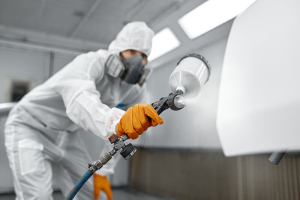How to Choose the Right Structural Adhesive for Mission-Critical Structures
How to Choose the Right Structural Adhesive for Mission-Critical Structures
Structural adhesives, or adhesives capable of overlap shear strengths of over 1000 PSI when bonding at room temperature, are a great solution for assembly operations because of their versatility. While mechanical fastening methods require you to drill a hole, or cause heat distortion from welding metal, structural adhesives don’t damage the contact surface of the material you’re working with.
In fact, structural adhesives have the highest load bearing capability when compared to other types of adhesives. By spreading out the contact surfaces you’re bonding together, you reduce concentrated stress areas while increasing bond fatigue resistance. Better yet, structural adhesives can be used to join different materials without corrosion and are adaptable to different sizes and shapes.
Because they don’t corrode materials, structural adhesives also allow for composite materials to be incorporated into a construction, so you can reduce the weight and maintain the strength metal materials throughout your structure. Offering excellent environmental and chemical resistance, structural adhesives are usually formulated to be completely solid to eliminate any solvent emissions.
There’s a wide array of characteristics and applications for structural adhesives making them less intuitive to use. Conditions to consider include environmental factors like temperature, humidity or UV exposure; resistance to chemicals like motor oil, cleaning solutions or specialized solvents; cleanliness challenges that could cause corrosion; or mechanical challenges like high impact/vibrational forces, along with thermal variations caused by friction.
The most common and versatile structural adhesive
Structural adhesives are categorized by chemistry: Epoxies (one and two-part formulations), acrylics (two-part and two-step formulations), urethanes (two-part formulations), and cyanoacrylates (also known as “instant adhesives”).
Epoxies are available in the widest range of properties and can have the best overall results with metals or thermoset composites. Standard 5-minute rigid epoxies that are commonly available in hardware stores, for example, tend to be brittle and are best suited to applications where relatively low stress and no impact are expected. Flexible epoxies like 3M™ Scotch-Weld™ Epoxy Adhesive 2216 have higher peel strengths to provide improved impact performance for parts that require some flexibility.
Toughened epoxies like 3M™ Scotch-Weld™ Epoxy Adhesive DP420 and DP460 incorporate elastomeric regions to absorb impact and provide resistance to shearing, peeling, impacts, vibration and fatigue. Regardless of the type, epoxies require rigorous cleaning of oils from metal joint surfaces for room temperature bonding.
Alternate Options for Structural Adhesives
Two-part acrylic structural adhesives conversely tend to bond well through many common stamping and forming oils, requiring less surface preparation to use than it’s epoxy counterpart. Acrylics provide the highest bonding strength on plastics while offering a solid bond for metals. However, acrylic adhesives tend to be less resistant to vibrations or impacts, and cure-shrink more than epoxies or urethanes.
Acrylic adhesives are flammable and spread fumes, so it’s important to make sure you’re using them in a well-ventilated area. Newer acrylic adhesives like 3M™ Scotch-Weld™ Low Odor Acrylic Adhesive DP8825NS and DP8810NS have eliminated flammable substances from their formulas, so you no longer have to worry about fire safety or getting light-headed.
Cyanoacrylate adhesives tend provide good shear strength on many plastics and rubbers but are rigid and show low peel and impact resistance, preventing them from being viable for long term applications on metals or glass. Conversely, urethanes tend to be quite flexible but have lower strength in general. Urethanes are usually the cheaper option, but they’re relatively good for plastic, rubber and composite bonding.
Matching the adhesive to your structure
With all that in mind, you can mix and match the different adhesives based on your need. As you become more familiar with each adhesive type, you’ll be able to find a nice range of solutions. For example, if you want to bond ABS plastic to stainless steel in moderate heat, low vibration environments, you’d want to use an epoxy or an acrylic adhesive. For bonding wood to plastic in an outdoor, high-impact area, a urethane adhesive would be your best bet.
There are many options for structural adhesives, with each having it’s own properties. Even the most carefully considered solution could have unseen problems. With a solid understanding of the different properties each adhesive type has to offer, you’ll be able to find a nice range of solutions as problems arise.
Ready To Learn More?
For more information on structural adhesives, please visit our Structural Adhesives section today.
30-Second Summary:
- ✔ Structural adhesives have the highest load bearing capability of overlap shear strengths over 1000 PSI when bonding metal at room temperature.
- ✔ Structural adhesives don’t damage the surface of the material you’re working with, can be used to join different materials without corrosion and are adaptable to different geometries.
- ✔ Structural adhesives come in four categories: Epoxies, acrylics, urethanes, and cyanoacrylates.
- ✔ Epoxies are the most common structural adhesive, offering a wide range of properties, and are ideal for bonding metals or composite materials. However, they require a pristine contact surface for a good bond.
- ✔ Acrylic structural adhesives provide the highest bonding strength on plastics and require less surface preparation to use, but they’re also less resistant to vibrations and cure-shrink more than epoxies or urethanes.
- ✔ Cyanoacrylate adhesives offer high shear strength on plastic and rubber materials, but are also rigid and show low peel or impact resistance, preventing long term applications on metal or glass.
- ✔ Urethanes adhesives are flexible and offer good plastic, rubber and composite bonding, but they’re a relatively cheaper, lower strength lower strength solution.









